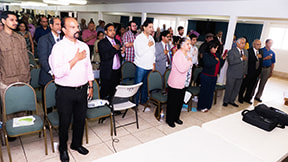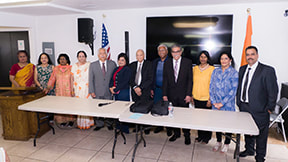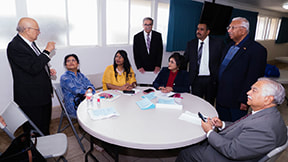By a Staff Reporter
NORWALK,CA - Indian American Heritage Foundation, in association with GOPIO Int’l, GOPIO-LA, GOPIO-IE, GOPIO-OC, Federation of Indian Community of Southern California, Indo American Social Association, Excel Foundation USA, Rajput Association of America,
NORWALK,CA - Indian American Heritage Foundation, in association with GOPIO Int’l, GOPIO-LA, GOPIO-IE, GOPIO-OC, Federation of Indian Community of Southern California, Indo American Social Association, Excel Foundation USA, Rajput Association of America,

and Apna Punjabi Group organized American Independence Day celebration on July 4, at Joy of Sharing Community Center, here and also paid tribute to Indian pioneers and patriots who started India independence movement in the US in the early 20th century. The celebration included a seminar which covered topics such as America’s War for Independence, Early Indian Immigration and Settlement, Struggle for US citizenship, Fight for India Independence (Gadar Movement), Indian-Americans’ Philanthropic Contributions to India and the US and Indian-Americans who have made India and Indian-Americans proud.
The seminar started with the national anthems of America and India by Henna Noor. Inder Singh, principal organizer, in his welcome remarks, talked about Americans’ sacrifices to gain freedom from the British. Many Americans lost their lives, properties, lifelong earnings during their fight for independence. He also talked about the early Indian immigrants’ unimagined hardships, racial violence, bigotry, and discrimination which they faced in the US.
Vasu Pawar, President GOPIO Inland Empire spoke of the American war of independence from the British. She said that the American colonies formed the First Continental Congress to persuade the British government to recognize their rights. When this didn’t work, the Declaration of Independence was adopted on July 4, 1776, and war was declared. Independence from Britain was won in 1783. The colonies became states and United States of America was born as a country. Ashok Madan, past president NFIA, spoke about Early Indian Immigration and Settlement Problems which Indian Immigrants faced when they came to in the US in the beginning of the twentieth century.
Rajbir S. Husson, President Indo American Social Association spoke about India Independence Movement known as Gadar Movement which was started in the US to free India from the yolk of British rule. After World War I started in 1914, several thousand overseas Indians went to India to free their motherland from the British. The British spies foiled their attempt to throw the British out of India. Many were arrested, 48 were given death sentence, and 69 life imprisonment. Inder Singh talked about the sacrifices of heroes of the Gadar movement, Sohan Singh Bhakna and Lala Hardyal. Rani Kuusto talked about Kartar Singh Sarabha, Aparna Hande spoke about Vishnu Ganesh Pingley and Dr. Asmath Noor talked about Maulvi Barkatullah.
A young high schooler Sagar Dhunna spoke on ‘Freedom is Not Free’ and won the hearts of the audience. He said, we live the way we do today because of the many brave men and women that have sacrificed their lives. There is no doubt that we paid a huge price for this freedom.
Kewal Kanda, treasurer GOPIO-Int’l, spoke about the Jallianwala Bagh Massacre and reminded the audience that this year is the centenary year of that incidence. He also told the audience how Gen Dyer sealed off the only exit and indiscriminately fired 1650 rounds in 10 minutes without warning and massacred over 1000 innocent and unarmed people who had gathered there to celebrate Baisakhi. Mahatma Gandhi was so moved by this massacre it became a prelude to his full commitment to the cause of Indian nationalism and independence from Britain.
Charu Shivakumar, President Excel Foundation, spoke about the struggle of Indians for US citizenship. After a long struggle, a bill was passed in the US Congress in 1946 allowing 100 Indians to become US citizens annually. President Truman invited Sardar JJ Singh and Anup Singh who had been fighting to gain citizenship rights, to the White House on July 2, 1946 to witness the signing off the bill into law.
Dilip Butani, GOPIO Area Coordinator, Southern California, talked about philanthropic contributions of Indians, which far outweigh those of any other recent immigrant community to the US. Inder Singh, gave a power point presentation displaying the names of Indian-Americans who have significantly contributed in the fields of science, sports, education, economy, agriculture, yoga, politics, and in several other fields of human endeavor. They have made Indian- Americans and India proud of for their achievements.
About 150 people attended the seminar. For many attendees,the history of Indians in America presented in the seminar, was an eye opener. Rajinder Dhunna, Baljinder Tahim, and Vilas Jadhav helped to manage the event.
The seminar started with the national anthems of America and India by Henna Noor. Inder Singh, principal organizer, in his welcome remarks, talked about Americans’ sacrifices to gain freedom from the British. Many Americans lost their lives, properties, lifelong earnings during their fight for independence. He also talked about the early Indian immigrants’ unimagined hardships, racial violence, bigotry, and discrimination which they faced in the US.
Vasu Pawar, President GOPIO Inland Empire spoke of the American war of independence from the British. She said that the American colonies formed the First Continental Congress to persuade the British government to recognize their rights. When this didn’t work, the Declaration of Independence was adopted on July 4, 1776, and war was declared. Independence from Britain was won in 1783. The colonies became states and United States of America was born as a country. Ashok Madan, past president NFIA, spoke about Early Indian Immigration and Settlement Problems which Indian Immigrants faced when they came to in the US in the beginning of the twentieth century.
Rajbir S. Husson, President Indo American Social Association spoke about India Independence Movement known as Gadar Movement which was started in the US to free India from the yolk of British rule. After World War I started in 1914, several thousand overseas Indians went to India to free their motherland from the British. The British spies foiled their attempt to throw the British out of India. Many were arrested, 48 were given death sentence, and 69 life imprisonment. Inder Singh talked about the sacrifices of heroes of the Gadar movement, Sohan Singh Bhakna and Lala Hardyal. Rani Kuusto talked about Kartar Singh Sarabha, Aparna Hande spoke about Vishnu Ganesh Pingley and Dr. Asmath Noor talked about Maulvi Barkatullah.
A young high schooler Sagar Dhunna spoke on ‘Freedom is Not Free’ and won the hearts of the audience. He said, we live the way we do today because of the many brave men and women that have sacrificed their lives. There is no doubt that we paid a huge price for this freedom.
Kewal Kanda, treasurer GOPIO-Int’l, spoke about the Jallianwala Bagh Massacre and reminded the audience that this year is the centenary year of that incidence. He also told the audience how Gen Dyer sealed off the only exit and indiscriminately fired 1650 rounds in 10 minutes without warning and massacred over 1000 innocent and unarmed people who had gathered there to celebrate Baisakhi. Mahatma Gandhi was so moved by this massacre it became a prelude to his full commitment to the cause of Indian nationalism and independence from Britain.
Charu Shivakumar, President Excel Foundation, spoke about the struggle of Indians for US citizenship. After a long struggle, a bill was passed in the US Congress in 1946 allowing 100 Indians to become US citizens annually. President Truman invited Sardar JJ Singh and Anup Singh who had been fighting to gain citizenship rights, to the White House on July 2, 1946 to witness the signing off the bill into law.
Dilip Butani, GOPIO Area Coordinator, Southern California, talked about philanthropic contributions of Indians, which far outweigh those of any other recent immigrant community to the US. Inder Singh, gave a power point presentation displaying the names of Indian-Americans who have significantly contributed in the fields of science, sports, education, economy, agriculture, yoga, politics, and in several other fields of human endeavor. They have made Indian- Americans and India proud of for their achievements.
About 150 people attended the seminar. For many attendees,the history of Indians in America presented in the seminar, was an eye opener. Rajinder Dhunna, Baljinder Tahim, and Vilas Jadhav helped to manage the event.



 RSS Feed
RSS Feed
